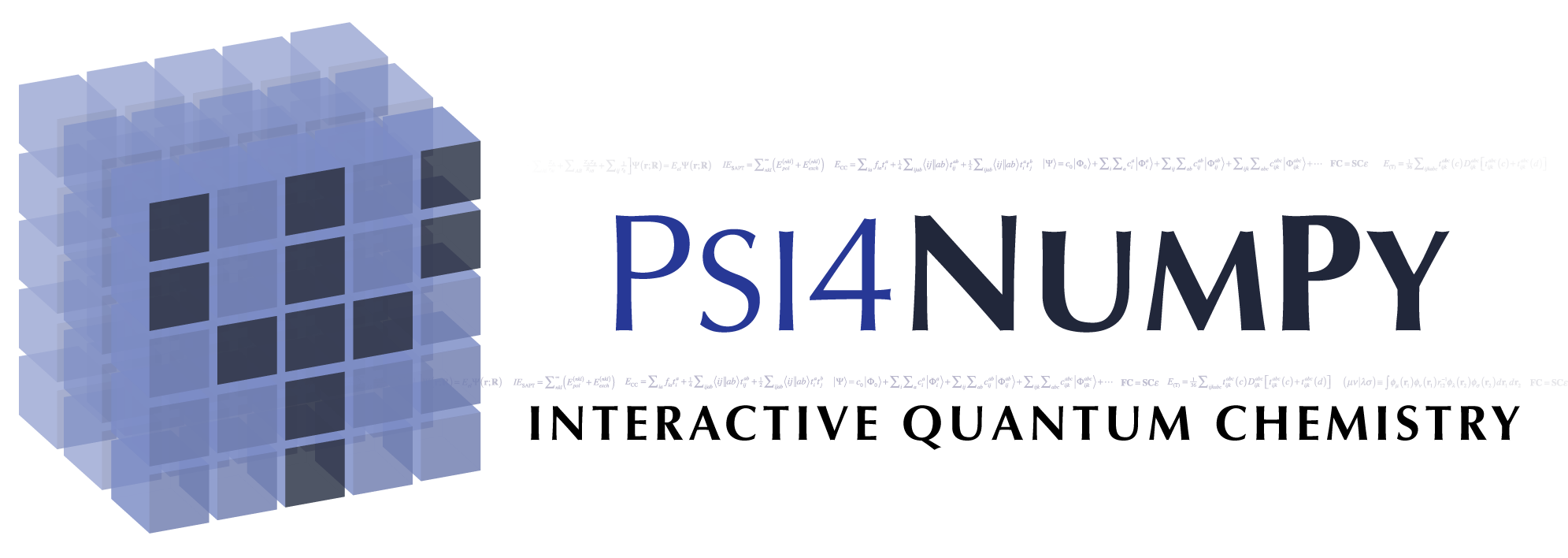What I cannot create, I do not understand. - Richard Feynman
The overall goal of the Psi4NumPy project is to provide an interactive quantum chemistry framework for reference implementations, rapid prototyping, development, and education. To do this, quantities relevant to quantum chemistry are computed with the Psi4 electronic structure package, and subsequently manipulated using the Numerical Python (NumPy) package. This combination provides an interface that is both simple to use and remains relatively fast to execute.
A series of short scripts demonstrating the implementation of Hartree-Fock Self-Consistent Field, SCF Response, Møller-Plesset Perturbation Theory, Symmetry-Adapted Perturbation Theory, Coupled Cluster Theory, and more are provided for the reference of the quantum chemistry community at large to facilitate both reproducibility and low-level methodological understanding. Additionally, the Tutorials folder above represents an interactive educational environment containing modules discussing the theory and implementation of various quantum and computational chemistry methods. By leveraging the popular Jupyter Notebook application, each tutorial is constructed as hybrid theory and programming in an easy to use interactive environment, removing the gap between theory and implementation.
If you have comments, questions, or would like to contribute to the project please see our contributor guidelines.
- Obtain required software
- Psi4NumPy (clone this repository; no install available)
- Psi4
- Option 1 (easiest): Download installer based on your preferred operating system and version of Python. Proceed to follow the instructions described at the bottom of that page.
- Option 2 (easy): Download Conda package according to instructions. To find the different versions available visit the anaconda website.
# Have Anaconda or Miniconda (https://conda.io/miniconda.html) >>> conda create -n p4env psi4 -c psi4 # Create a new environment named p4env and install psi4. >>> bash >>> source activate p4env - Option 3 (medium): Clone source and compile according to instructions
# Get Psi4 source >>> git clone https://github.com/psi4/psi4.git >>> git checkout v1.1 >>> cmake -H. -Bobjdir -Doption=value ... >>> cd objdir && make -j`getconf _NPROCESSORS_ONLN` # Find `psi4` command at objdir/stage/<TAB>/<TAB>/.../bin/psi4; adjust path if needed
- Python 3.6+ (incl. w/ Psi4 Options 1 & 2)
- NumPy 1.7.2+ (incl. w/ Psi4 Options 1 & 2)
- Scipy 0.13.0+
- Enable Psi4 & PsiAPI (if Psi4 was built from source)
- Find appropriate paths
>>> psi4 --psiapi-path export PATH=/path/to/dir/of/python/interpreter/against/which/psi4/compiled:$PATH export PYTHONPATH=/path/to/dir/of/psi4/core-dot-so:$PYTHONPATH - Export relevant paths
>>> bash >>> export PATH=/path/to/dir/of/python/interpreter/against/which/psi4/compiled:$PATH >>> export PYTHONPATH=/path/to/dir/of/psi4/core-dot-so:$PYTHONPATH
- Find appropriate paths
- Run scripts as conventional Python scripts
- Example: Run
DF-MP2.py>>> python psi4numpy/Moller-Plesset/DF-MP2.py
- Example: Run
New users can follow the Tutorials or the PsiAPI documentation for an introduction to running Psi4 within the PsiAPI.
A tutorial that covers the basics of NumPy can be found here.
This repository contains
- reference implementations, which provide working Python scripts implementing various quantum chemical methods, and
- interactive tutorials, which provide Jupyter notebooks presenting a hybrid theory-and-implementation educational framework for learning to program quantum chemistry methods.
Reference implementations are organized into top-level directories corresponding to the over-arching theory upon which each method is based, i.e., both EOM-CCSD and TD-CCSD are contained in the Coupled-Cluster directory. All interactive tutorials are contained in the top-level directory Tutorials. These tutorials are organized in logical order of progression, which is enumerated in detail here.
This repostitory has recently been updated to be compatible with Psi4 version 1.1. Please see the v0.1-beta tag for a Psi4 v1.0 compliant Psi4NumPy version.
This reposititory is fully compatible with the upcoming Psi4 version 1.2. In fact (for a while), if you use v1.2, there's no need to worry if your Psi4 has all the features to run all the reference implementations and tutorials.
Please consider citing this repository through the Psi4NumPy paper:
Psi4NumPy: An Interactive Quantum Chemistry Programming Environment for Reference Implementations and Rapid Development Daniel G. A. Smith, Lori A. Burns, Dominic A. Sirianni, Daniel R. Nascimento, Ashutosh Kumar, Andrew M. James, Jeffrey B. Schriber, Tianyuan Zhang, Boyi Zhang, Adam S. Abbott, Eric J. Berquist, Marvin H. Lechner, Leonardo A. Cunha, Alexander G. Heide, Jonathan M. Waldrop, Tyler Y. Takeshita, Asem Alenaizan, Daniel Neuhauser, Rollin A. King, Andrew C. Simmonett, Justin M. Turney, Henry F. Schaefer, Francesco A. Evangelista, A. Eugene DePrince III, T. Daniel Crawford, Konrad Patkowski, and C. David Sherrill Journal of Chemical Theory and Computation, 2018, 14 (7), 3504-3511 DOI: 10.1021/acs.jctc.8b00286





